Abstract expressionism is a post–World War II art movement in American painting, developed in New York City in the 1940s. It was the first specifically American movement to achieve international influence and put New York at the center of the Western art world, a role formerly filled by Paris.
Action painting, sometimes called "gestural abstraction", is a style of painting in which paint is spontaneously dribbled, splashed or smeared onto the canvas, rather than being carefully applied. The resulting work often emphasizes the physical act of painting itself as an essential aspect of the finished work or concern of its artist.

Willem de Kooning was a Dutch-American abstract expressionist artist. He was born in Rotterdam and moved to the United States in 1926, becoming an American citizen in 1962. In 1943, he married painter Elaine Fried.
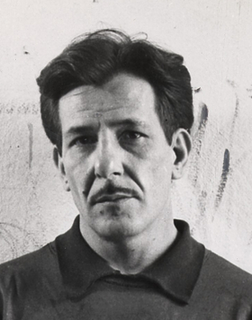
Franz Kline was an American painter. He is associated with the Abstract Expressionist movement of the 1940s and 1950s. Kline, along with other action painters like Jackson Pollock, Willem de Kooning, Robert Motherwell, John Ferren, and Lee Krasner, as well as local poets, dancers, and musicians came to be known as the informal group, the New York School. Although he explored the same innovations to painting as the other artists in this group, Kline's work is distinct in itself and has been revered since the 1950s.
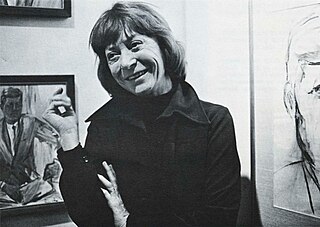
Elaine Marie Catherine de Kooning was an Abstract Expressionist and Figurative Expressionist painter in the post-World War II era. She wrote extensively on the art of the period and was an editorial associate for Art News magazine.
Gabriel Laderman was a New York painter and an early and important exponent of the Figurative revival of the 1950s and 1960s.
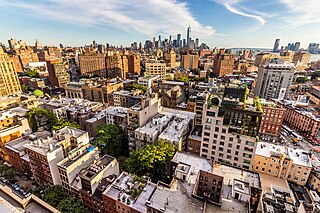
The 9th Street Art Exhibition of Paintings and Sculpture is the official title artist Franz Kline hand-lettered onto the poster he designed for the Ninth Street Show. Now considered historic, the artist-led exhibition marked the formal debut of Abstract Expressionism, and the first American art movement with international influence. The School of Paris, long the headquarters of the global art market, typically launched new movements, so there was both financial and cultural fall-out when all the excitement was suddenly emanating from New York. The post-war New York avant-garde, artists like Willem de Kooning and Jackson Pollock, would soon become "art stars," commanding large sums and international attention. The Ninth Street Show marked their "stepping-out," and that of nearly 75 other artists, including Harry Jackson, Helen Frankenthaler, Joan Mitchell, Grace Hartigan, Robert De Niro Sr., Philip Guston, Elaine de Kooning, Lee Krasner, Franz Kline, Ad Reinhardt, David Smith, Milton Resnick, Joop Sanders, Robert Motherwell, Barnett Newman and many others who were then mostly unknown to an art establishment that ignored experimental art without a ready market.

The Cedar Tavern was a bar and restaurant at the eastern edge of Greenwich Village, New York City. In its heyday, known as a gathering place for avant garde writers and artists, it was located at 24 University Place, near 8th Street. It was famous in its day as a hangout of many prominent Abstract Expressionist painters and Beat writers and poets. It closed in April 1963 and reopened three blocks north in 1964, at 82 University Place, between 11th and 12th Streets.
Michael Goldberg was an American abstract expressionist painter and teacher known for his gestural action paintings, abstractions and still-life paintings. A retrospective show, "Abstraction Over Time: The Paintings of Michael Goldberg", was shown at MOCA Jacksonville in Florida from 9/21/13 to 1/5/14. His work was seen in September 2007 in a solo exhibition at Knoedler & Company in New York City, as well as several exhibitions at Manny Silverman Gallery in Los Angeles. Additionally, a survey of Goldberg's work is exhibited at the University Art Museum at California State University, Long Beach since September 2010.

Nicolas Carone belonged to the early generation of New York School Abstract Expressionist artists. Their artistic innovation by the 1950s had been recognized internationally, including in London and Paris. New York School Abstract Expressionism, represented by Jackson Pollock, Willem de Kooning, Franz Kline, Conrad Marca-Relli and others, became a leading art movement of the postwar era.
Joop Sanders is a Dutch-American painter, educator, and founding member of the American Abstract Expressionist group. He is the youngest member of the first generation of the New York School.

20th-century Western painting begins with the heritage of late-19th-century painters Vincent van Gogh, Paul Cézanne, Paul Gauguin, Georges Seurat, Henri de Toulouse-Lautrec, and others who were essential for the development of modern art. At the beginning of the 20th century, Henri Matisse and several other young artists including the pre-cubist Georges Braque, André Derain, Raoul Dufy and Maurice de Vlaminck, revolutionized the Paris art world with "wild", multi-colored, expressive landscapes and figure paintings that the critics called Fauvism. Matisse's second version of The Dance signified a key point in his career and in the development of modern painting. It reflected Matisse's incipient fascination with primitive art: the intense warm color of the figures against the cool blue-green background and the rhythmical succession of the dancing nudes convey the feelings of emotional liberation and hedonism.

American Figurative Expressionism is a 20th-century visual art style or movement that first took hold in Boston, and later spread throughout the United States. Critics dating back to the origins of Expressionism have often found it hard to define. One description, however, classifies it as a Humanist philosophy, since it's human-centered and rationalist. Its formal approach to the handling of paint and space is often considered a defining feature, too, as is its radical, rather than reactionary, commitment to the figure.
Thomas Sills was a painter and collagist and a participant in the New York Abstract Expressionist movement. At the peak of his career in the 1960s and 1970s, his work was widely shown in museums. His work was regularly featured in art journals and is in museum collections.
Michael Loew was an American Abstract Expressionist artist who was born in New York City.
Ronan Walsh who represented Ireland at the 1988 Art Junction in Nice and has exhibited work throughout Europe and North America.
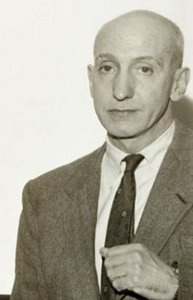
George McNeil was an American abstract expressionist painter.

In 1953, Woman, a series of abstract works of art painted by Willem de Kooning, shocked the public who visited de Kooning’s third one-man show at the Sidney Janis Gallery in Manhattan. The last painting of this series, Woman VI, is displayed at the Carnegie Museum of Art as part of the Postwar Abstraction collection since the 1955 Carnegie International Exhibition. Willem de Kooning is a pioneer of abstract expressionism in America. This painting is a good example of contemporary art’s transition from European traditional painting to abstract expressionism; Woman is considered de Kooning’s most famous series because it is significant to postwar history and social events, such as the American Feminist Movement in 1960s; de Kooning has a ventured impact on the issue of the representation of woman during 1950s through the abstract form; and, above all, Woman VI is an irreplaceable work of art for the Postwar Abstraction collection not only for its abstract form and brushwork techniques but because it still has the ability to create multiple interpretations with each viewing.
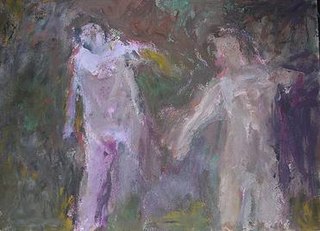
Milton Resnick was an American artist noted for abstract paintings that coupled scale with density of incident. It was not uncommon for some of the largest paintings to weigh in excess three hundred pounds, almost all of it pigment. He had a long and varied career, lasting about sixty-five years. He produced at least eight hundred canvases and eight thousand works on paper and board.

Interchange, also known as Interchanged, is an abstract expressionist oil painting on canvas by Dutch-American painter Willem de Kooning (1904–1997). Like Jackson Pollock, de Kooning was one of the early artists of the abstract expressionism movement, the first American modern art movement. The painting measures 200.7 by 175.3 centimetres and was completed in 1955. It marked the transition of the subjects of de Kooning's paintings from women to abstract urban landscapes. It reflects a transition in de Kooning's painting technique due the influence of artist Franz Kline, who inspired de Kooning to paint with quickly made gestural marks as opposed to violent brush strokes. The painting features a fleshy pink mass at its center, representing a seated woman.











